
- •About the Author
- •About the Technical Editor
- •Credits
- •Is This Book for You?
- •Software Versions
- •Conventions This Book Uses
- •What the Icons Mean
- •How This Book Is Organized
- •How to Use This Book
- •What’s on the Companion CD
- •What Is Excel Good For?
- •What’s New in Excel 2010?
- •Moving around a Worksheet
- •Introducing the Ribbon
- •Using Shortcut Menus
- •Customizing Your Quick Access Toolbar
- •Working with Dialog Boxes
- •Using the Task Pane
- •Creating Your First Excel Worksheet
- •Entering Text and Values into Your Worksheets
- •Entering Dates and Times into Your Worksheets
- •Modifying Cell Contents
- •Applying Number Formatting
- •Controlling the Worksheet View
- •Working with Rows and Columns
- •Understanding Cells and Ranges
- •Copying or Moving Ranges
- •Using Names to Work with Ranges
- •Adding Comments to Cells
- •What Is a Table?
- •Creating a Table
- •Changing the Look of a Table
- •Working with Tables
- •Getting to Know the Formatting Tools
- •Changing Text Alignment
- •Using Colors and Shading
- •Adding Borders and Lines
- •Adding a Background Image to a Worksheet
- •Using Named Styles for Easier Formatting
- •Understanding Document Themes
- •Creating a New Workbook
- •Opening an Existing Workbook
- •Saving a Workbook
- •Using AutoRecover
- •Specifying a Password
- •Organizing Your Files
- •Other Workbook Info Options
- •Closing Workbooks
- •Safeguarding Your Work
- •Excel File Compatibility
- •Exploring Excel Templates
- •Understanding Custom Excel Templates
- •Printing with One Click
- •Changing Your Page View
- •Adjusting Common Page Setup Settings
- •Adding a Header or Footer to Your Reports
- •Copying Page Setup Settings across Sheets
- •Preventing Certain Cells from Being Printed
- •Preventing Objects from Being Printed
- •Creating Custom Views of Your Worksheet
- •Understanding Formula Basics
- •Entering Formulas into Your Worksheets
- •Editing Formulas
- •Using Cell References in Formulas
- •Using Formulas in Tables
- •Correcting Common Formula Errors
- •Using Advanced Naming Techniques
- •Tips for Working with Formulas
- •A Few Words about Text
- •Text Functions
- •Advanced Text Formulas
- •Date-Related Worksheet Functions
- •Time-Related Functions
- •Basic Counting Formulas
- •Advanced Counting Formulas
- •Summing Formulas
- •Conditional Sums Using a Single Criterion
- •Conditional Sums Using Multiple Criteria
- •Introducing Lookup Formulas
- •Functions Relevant to Lookups
- •Basic Lookup Formulas
- •Specialized Lookup Formulas
- •The Time Value of Money
- •Loan Calculations
- •Investment Calculations
- •Depreciation Calculations
- •Understanding Array Formulas
- •Understanding the Dimensions of an Array
- •Naming Array Constants
- •Working with Array Formulas
- •Using Multicell Array Formulas
- •Using Single-Cell Array Formulas
- •Working with Multicell Array Formulas
- •What Is a Chart?
- •Understanding How Excel Handles Charts
- •Creating a Chart
- •Working with Charts
- •Understanding Chart Types
- •Learning More
- •Selecting Chart Elements
- •User Interface Choices for Modifying Chart Elements
- •Modifying the Chart Area
- •Modifying the Plot Area
- •Working with Chart Titles
- •Working with a Legend
- •Working with Gridlines
- •Modifying the Axes
- •Working with Data Series
- •Creating Chart Templates
- •Learning Some Chart-Making Tricks
- •About Conditional Formatting
- •Specifying Conditional Formatting
- •Conditional Formats That Use Graphics
- •Creating Formula-Based Rules
- •Working with Conditional Formats
- •Sparkline Types
- •Creating Sparklines
- •Customizing Sparklines
- •Specifying a Date Axis
- •Auto-Updating Sparklines
- •Displaying a Sparkline for a Dynamic Range
- •Using Shapes
- •Using SmartArt
- •Using WordArt
- •Working with Other Graphic Types
- •Using the Equation Editor
- •Customizing the Ribbon
- •About Number Formatting
- •Creating a Custom Number Format
- •Custom Number Format Examples
- •About Data Validation
- •Specifying Validation Criteria
- •Types of Validation Criteria You Can Apply
- •Creating a Drop-Down List
- •Using Formulas for Data Validation Rules
- •Understanding Cell References
- •Data Validation Formula Examples
- •Introducing Worksheet Outlines
- •Creating an Outline
- •Working with Outlines
- •Linking Workbooks
- •Creating External Reference Formulas
- •Working with External Reference Formulas
- •Consolidating Worksheets
- •Understanding the Different Web Formats
- •Opening an HTML File
- •Working with Hyperlinks
- •Using Web Queries
- •Other Internet-Related Features
- •Copying and Pasting
- •Copying from Excel to Word
- •Embedding Objects in a Worksheet
- •Using Excel on a Network
- •Understanding File Reservations
- •Sharing Workbooks
- •Tracking Workbook Changes
- •Types of Protection
- •Protecting a Worksheet
- •Protecting a Workbook
- •VB Project Protection
- •Related Topics
- •Using Excel Auditing Tools
- •Searching and Replacing
- •Spell Checking Your Worksheets
- •Using AutoCorrect
- •Understanding External Database Files
- •Importing Access Tables
- •Retrieving Data with Query: An Example
- •Working with Data Returned by Query
- •Using Query without the Wizard
- •Learning More about Query
- •About Pivot Tables
- •Creating a Pivot Table
- •More Pivot Table Examples
- •Learning More
- •Working with Non-Numeric Data
- •Grouping Pivot Table Items
- •Creating a Frequency Distribution
- •Filtering Pivot Tables with Slicers
- •Referencing Cells within a Pivot Table
- •Creating Pivot Charts
- •Another Pivot Table Example
- •Producing a Report with a Pivot Table
- •A What-If Example
- •Types of What-If Analyses
- •Manual What-If Analysis
- •Creating Data Tables
- •Using Scenario Manager
- •What-If Analysis, in Reverse
- •Single-Cell Goal Seeking
- •Introducing Solver
- •Solver Examples
- •Installing the Analysis ToolPak Add-in
- •Using the Analysis Tools
- •Introducing the Analysis ToolPak Tools
- •Introducing VBA Macros
- •Displaying the Developer Tab
- •About Macro Security
- •Saving Workbooks That Contain Macros
- •Two Types of VBA Macros
- •Creating VBA Macros
- •Learning More
- •Overview of VBA Functions
- •An Introductory Example
- •About Function Procedures
- •Executing Function Procedures
- •Function Procedure Arguments
- •Debugging Custom Functions
- •Inserting Custom Functions
- •Learning More
- •Why Create UserForms?
- •UserForm Alternatives
- •Creating UserForms: An Overview
- •A UserForm Example
- •Another UserForm Example
- •More on Creating UserForms
- •Learning More
- •Why Use Controls on a Worksheet?
- •Using Controls
- •Reviewing the Available ActiveX Controls
- •Understanding Events
- •Entering Event-Handler VBA Code
- •Using Workbook-Level Events
- •Working with Worksheet Events
- •Using Non-Object Events
- •Working with Ranges
- •Working with Workbooks
- •Working with Charts
- •VBA Speed Tips
- •What Is an Add-In?
- •Working with Add-Ins
- •Why Create Add-Ins?
- •Creating Add-Ins
- •An Add-In Example
- •System Requirements
- •Using the CD
- •What’s on the CD
- •Troubleshooting
- •The Excel Help System
- •Microsoft Technical Support
- •Internet Newsgroups
- •Internet Web sites
- •End-User License Agreement
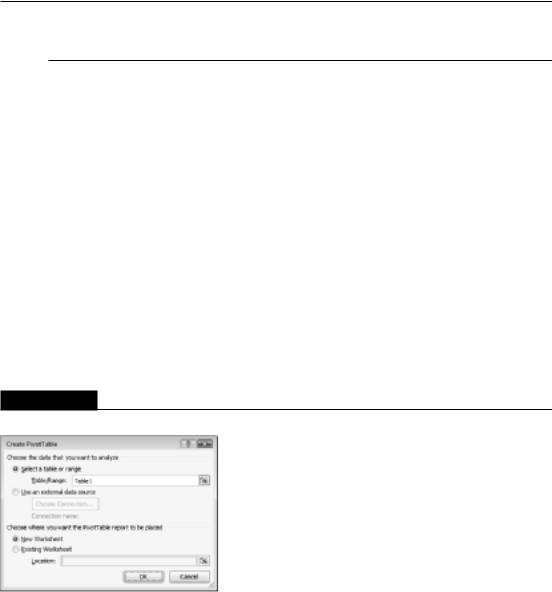
Chapter 34: Introducing Pivot Tables
Creating a Pivot Table
In this section, I describe the basic steps required to create a pivot table, using the bank account data described earlier in this chapter. Creating a pivot table is an interactive process. It’s not at all uncommon to experiment with various layouts until you find one that you’re satisfied with.
If you’re unfamiliar with the elements of a pivot table, see the upcoming sidebar, “Pivot Table Terminology.”
Specifying the data
If your data is in a worksheet range, select any cell in that range and then choose Insert Tables PivotTable, which displays the dialog box shown in Figure 34.7.
Excel attempts to guess the range, based on the location of the active cell. If you’re creating a pivot table from an external data source, you need to select that option and then click Choose Connection to specify the data source.
Tip
If you’re creating a pivot table from data in a worksheet, it’s a good idea to first create a table for the range (choose Insert Tables Table). Then, if you expand the table by adding new rows of data, Excel will refresh the pivot table without the need to manually indicate the new data range. n
FIGURE 34.7
In the Create PivotTable dialog box, you tell Excel where the data is and where you want the pivot table.
Specifying the location for the pivot table
Use the bottom section of the Create PivotTable dialog box to indicate the location for your pivot table. The default location is on a new worksheet, but you can specify any range on any worksheet, including the worksheet that contains the data.
701
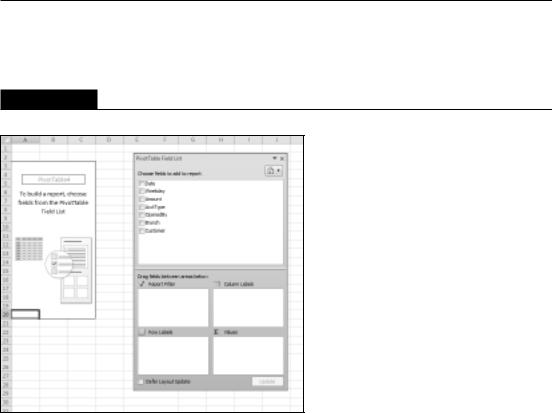
Part V: Analyzing Data with Excel
Click OK, and Excel creates an empty pivot table and displays its PivotTable Field List task pane, as shown in Figure 34.8.
FIGURE 34.8
Use the PivotTable Field List to build the pivot table.
Tip
The PivotTable Field List is typically docked on the right side of the Excel window. Drag its title bar to move it anywhere you like. Also, if you click a cell outside the pivot table, the PivotTable Field List is hidden. n
Laying out the pivot table
Next, set up the actual layout of the pivot table. You can do so by using either of any techniques:
•Drag the field names (at the top) to one of the four boxes at the bottom of the PivotTable Field List.
•Place a check mark next to the item at the top of the PivotTable Field List. Excel will place the field into one of the four boxes at the bottom.
•Right-click a field name at the top of the PivotTable Field List and choose its location from the shortcut menu.
702
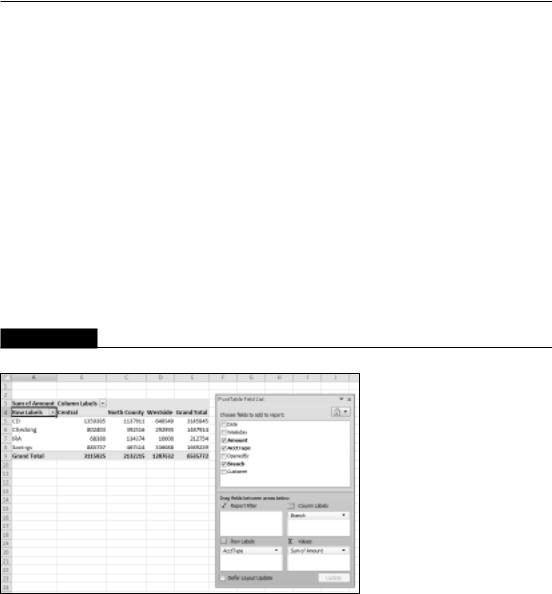
Chapter 34: Introducing Pivot Tables
Note
In versions prior to Excel 2007, you could drag items from the field list directly into the appropriate area of the pivot table. This feature is still available, but it’s turned off by default. To enable this feature, choose PivotTable Tools Options PivotTable Options Options to display the PivotTable Options dialog box. Click the Display tab and then select the Classic PivotTable Layout check box. n
The following steps create the pivot table presented earlier in this chapter (see “A pivot table example”). For this example, I drag the items from the top of the PivotTable Field List to the areas in the bottom of the PivotTable Field List.
1.Drag the Amount field into the Values area. At this point, the pivot table displays the total of all the values in the Amount column.
2.Drag the AcctType field into the Row Labels area. Now the pivot table shows the total amount for each of the account types.
3.Drag the Branch field into the Column Labels area. The pivot table shows the amount for each account type, cross-tabulated by branch (see Figure 34.9). The pivot table updates itself automatically with every change you make in the PivotTable Field List.
FIGURE 34.9
After a few simple steps, the pivot table shows a summary of the data.
Formatting the pivot table
Notice that the pivot table uses General number formatting. To change the number format for all data, right-click any value and choose Number Format from the shortcut menu. Then use the Format Cells dialog box to change the number format for the displayed data.
703

Part V: Analyzing Data with Excel
You can apply any of several built-in styles to a pivot table. Select any cell in the pivot table and then choose PivotTable Tools Design PivotTable Styles to select a style.
You also can use the controls from the PivotTable Design Layout group to control various elements in the pivot table. For example, you can choose to hide the grand totals if you prefer.
The PivotTable Tools Options Show group contains additional options that affect the appearance of your pivot table. For example, you use the Show Field Headers button to toggle the display of the field headings.
Still more pivot table options are available from the PivotTable Options dialog box, shown in Figure 34.10. To display this dialog box, choose PivotTable Tools Options PivotTable
Options. Or, right-click any cell in the pivot table and choose Table Options from the shortcut menu.
Pivot Table Terminology
Understanding the terminology associated with pivot tables is the first step in mastering this feature. Refer to the accompanying figure to get your bearings.
•Column labels: A field that has a column orientation in the pivot table. Each item in the field occupies a column. In the figure, Customer represents a column field that contains two items (Existing and New). You can have nested column fields.
•Grand totals: A row or column that displays totals for all cells in a row or column in a pivot table. You can specify that grand totals be calculated for rows, columns, or both (or neither). The pivot table in the figure shows grand totals for both rows and columns.
•Group: A collection of items treated as a single item. You can group items manually or automatically (group dates into months, for example). The pivot table in the figure does not have any defined groups.
704
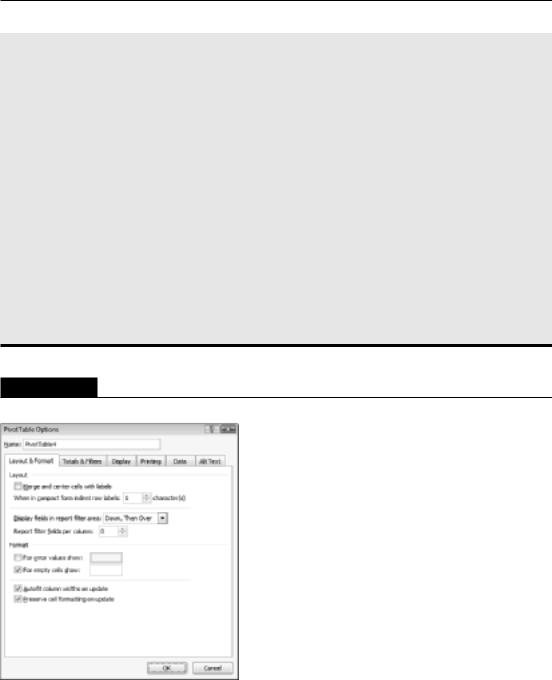
Chapter 34: Introducing Pivot Tables
•Item: An element in a field that appears as a row or column header in a pivot table. In the figure, Existing and New are items for the Customer field. The Branch field has three items: Central, North County, and Westside. AcctType has four items: CD, Checking, IRA, and Savings.
•Refresh: Recalculates the pivot table after making changes to the source data.
•Row labels: A field that has a row orientation in the pivot table. Each item in the field occupies a row. You can have nested row fields. In the figure, Branch and AcctType both represent row fields.
•Source data: The data used to create a pivot table. It can reside in a worksheet or an external database.
•Subtotals: A row or column that displays subtotals for detail cells in a row or column in a pivot table. The pivot table in the figure displays subtotals for each branch.
•Table Filter: A field that has a page orientation in the pivot table — similar to a slice of a three-dimensional cube. You can display only one item (or all items) in a page field at one time. In the figure, OpenedBy represents a page field that displays All (that is, not filtered). In previous version of Excel, a table filter was known as a Page field.
•Values area: The cells in a pivot table that contain the summary data. Excel offers several ways to summarize the data (sum, average, count, and so on).
FIGURE 34.10
The PivotTable Options dialog box.
705
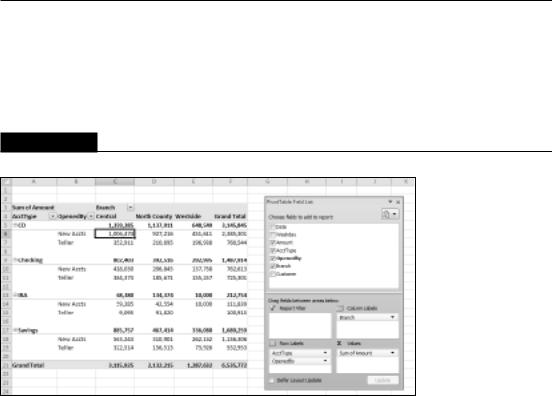
Part V: Analyzing Data with Excel
Modifying the pivot table
After you create a pivot table, changing it is easy. For example, you can add further summary information by using the PivotTable Field List. Figure 34.11 shows the pivot table after I dragged a second field (OpenedBy) to the Row Labels section in the PivotTable Field List.
FIGURE 34.11
Two fields are used for row labels.
The following are some tips on other pivot table modifications you can make:
•To remove a field from the pivot table, select it in the bottom part of the PivotTable Field List and then drag it away.
•If an area has more than one field, you can change the order in which the fields are listed by dragging the field names. Doing so affects the appearance of the pivot table.
•To temporarily remove a field from the pivot table, remove the check mark from the field name in the top part of the PivotTable Field List. The pivot table is redisplayed without that field. Place the check mark back on the field name, and it appears in its previous section.
•If you add a field to the Report Filter section, the field items appear in a drop-down list, which allows you to filter the displayed data by one or more items. Figure 34.12 shows an example. I dragged the Date field to the Report Filter area. The report is now showing the data only for a single day (which I selected from the drop-down list in cell B1).
706
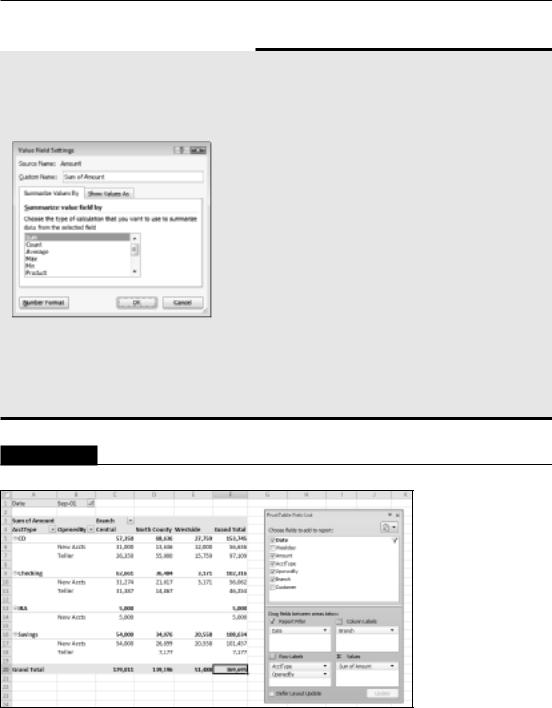
Chapter 34: Introducing Pivot Tables
Pivot Table Calculations
Pivot table data is most frequently summarized using a sum. However, you can display your data using a number of different summary techniques. Select any cell in the Values area of your pivot table and then choose PivotTable Tools Options Active Field Field Settings to display the Value Field Settings dialog box. This dialog box has two tabs: Summarize Values By and Show Values As.
Use the Summarize Values By tab to select a different summary function. Your choices are Sum, Count, Average, Max, Min, Product, Count Numbers, StdDev, StdDevp, Var, and Varp.
To display your values in a different form, use the drop-down control on the Show Values As tab. You have many options to choose from, including as a percentage of the total or subtotal.
FIGURE 34.12
The pivot table is filtered by date.
707
